Vintage barstools bring a touch of nostalgia, character, and timeless charm to any home decor. Whether you’re furnishing a kitchen island, a home bar, or a counter seating area, vintage barstools offer a unique and stylish seating option that stands out from the crowd. With their classic designs, quality craftsmanship, and enduring appeal, vintage barstools not only provide functionality but also add a touch of vintage elegance to your space. In this article, we will explore the allure of vintage barstools, their design elements, and how they can enhance the aesthetic appeal of your home.
Vintage barstools evoke a sense of nostalgia and create a unique atmosphere in any space. They tell a story of the past and add a touch of character and individuality to your home. Whether you have a modern, rustic, or eclectic interior, vintage barstools can seamlessly blend in and become a standout piece that sparks conversation and admiration. Discover the perfect blend of nostalgia and style with vintage barstools, a delightful addition to your home renovation, creating a cozy and classic ambiance.
The Timeless Appeal of Vintage Barstools
Vintage barstools have an enduring appeal that transcends trends and fads. They capture the craftsmanship, design aesthetics, and materials of a bygone era, reflecting a sense of history and authenticity. The beauty of vintage barstools lies in their ability to effortlessly blend with a variety of décor styles, adding a touch of vintage charm to any space.

Design Elements of Vintage Barstools
Vintage barstools exhibit a range of design elements that contribute to their timeless appeal. Here are some key features to look for:
Quality Craftsmanship: Vintage barstools are often crafted with attention to detail and quality materials, resulting in sturdy and durable pieces that can withstand the test of time.
Classic Silhouettes: Vintage bar stools come in various styles, from sleek and streamlined to ornate and detailed. Classic silhouettes, such as straight lines, curved backs, and tapered legs, are common design elements that add elegance and sophistication.
Authentic Patina: The natural wear and patina acquired over time give vintage barstools a unique character and charm. These signs of age and use enhance the vintage aesthetic and tell a story of their own.
Materials and Finishes
Vintage barstools are crafted from a variety of materials, each offering its own distinctive look and feel. Common materials used in vintage barstool construction include:
Wood: Wood is a popular choice for vintage bar stools due to its warmth, durability, and versatility. Different types of wood, such as oak, walnut, or teak, can be used to create unique aesthetics.
Metal: Metal barstools, particularly those with chrome or wrought iron frames, were popular during mid-century eras. They offer a sleek and industrial appeal that complements modern and eclectic styles.
Upholstery: Vintage barstools often feature upholstered seats or backs, providing comfort and adding an extra layer of visual interest. Fabrics like vinyl, leather, or patterned textiles were commonly used in the upholstery.
Finishes: Vintage barstools may showcase various finishes, such as stained wood, painted surfaces, or distressed patinas. These finishes contribute to the overall vintage look and feel of the barstools.
Versatility in Home Décor
Vintage barstools can seamlessly integrate into a range of home decor styles, adding a unique focal point to your space. Here are some ideas for incorporating vintage barstools:
Eclectic Mix: Blend vintage barstools with other styles and eras to create an eclectic and curated look. Mix different materials, colors, and textures for a visually interesting seating arrangement.
Retro Revival: Embrace the nostalgia of the past by pairing vintage barstools with retro-inspired decor. Think vibrant colors, bold patterns, and playful accents that pay homage to a specific era.
Farmhouse Charm: Vintage wooden barstools with distressed finishes can add a touch of rustic charm to a farmhouse-style kitchen or dining area. Pair them with reclaimed wood elements and vintage accessories for a cohesive look.
Industrial Vibes: Metal barstools with clean lines and minimal embellishments lend themselves well to industrial-style spaces. Combine them with exposed brick, raw materials, and utilitarian lighting for an urban loft feel.
Finding and Restoring Vintage Barstools
Finding vintage bar stools can be an exciting treasure hunt. Explore flea markets, antique stores, online marketplaces, and estate sales to discover unique and authentic pieces. When sourcing vintage barstools, keep in mind the desired style, condition, and compatibility with your space.
If you come across vintage bar stools in need of restoration, consider the following steps:
Assessment: Evaluate the condition of the barstools, noting any structural issues, missing parts, or necessary repairs.
Cleaning: Clean the barstools thoroughly, removing dirt, grime, and old finishes. Be cautious when using cleaning agents to preserve the original materials.
Repair and Refinish: Repair any structural damage and restore the barstools to their former glory. This may involve replacing parts, reupholstering seats, or refinishing wood surfaces.
Preservation: Once restored, protect and maintain the vintage barstools by following appropriate care instructions. Regular cleaning and periodic inspections will help preserve their beauty and longevity.
Maintenance and Care
Proper maintenance and care are essential for preserving the beauty and longevity of vintage barstools. Here are some general tips to keep in mind:
Regular Cleaning: Dust the barstools regularly and clean any spills or stains promptly. Use mild cleaning agents suitable for the specific material and finish of the barstools.
Avoid Harsh Chemicals: Harsh cleaning chemicals can damage the original finishes or upholstery of vintage barstools. Opt for gentle cleaning solutions and test them in inconspicuous areas first.
Protective Measures: Place felt pads or protective caps on the bottom of the barstool legs to prevent scratches on the floor surface. Consider using seat cushions or covers to protect the upholstery.
Conclusion
Embracing vintage bar stools in your home décor brings a touch of timeless charm and individuality. Their classic designs, quality craftsmanship, and unique character make them a standout piece that adds warmth and elegance to any space. Whether you prefer a rustic farmhouse feel or a retro-inspired ambiance, vintage barstools can effortlessly elevate your home’s aesthetic and create a welcoming and stylish seating area.

